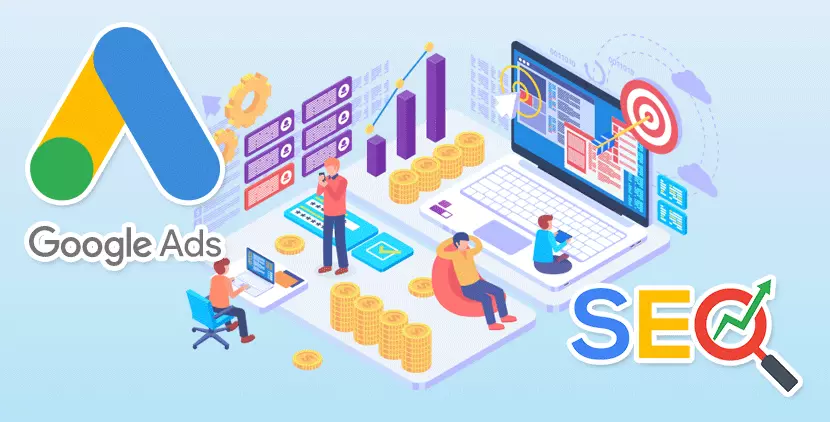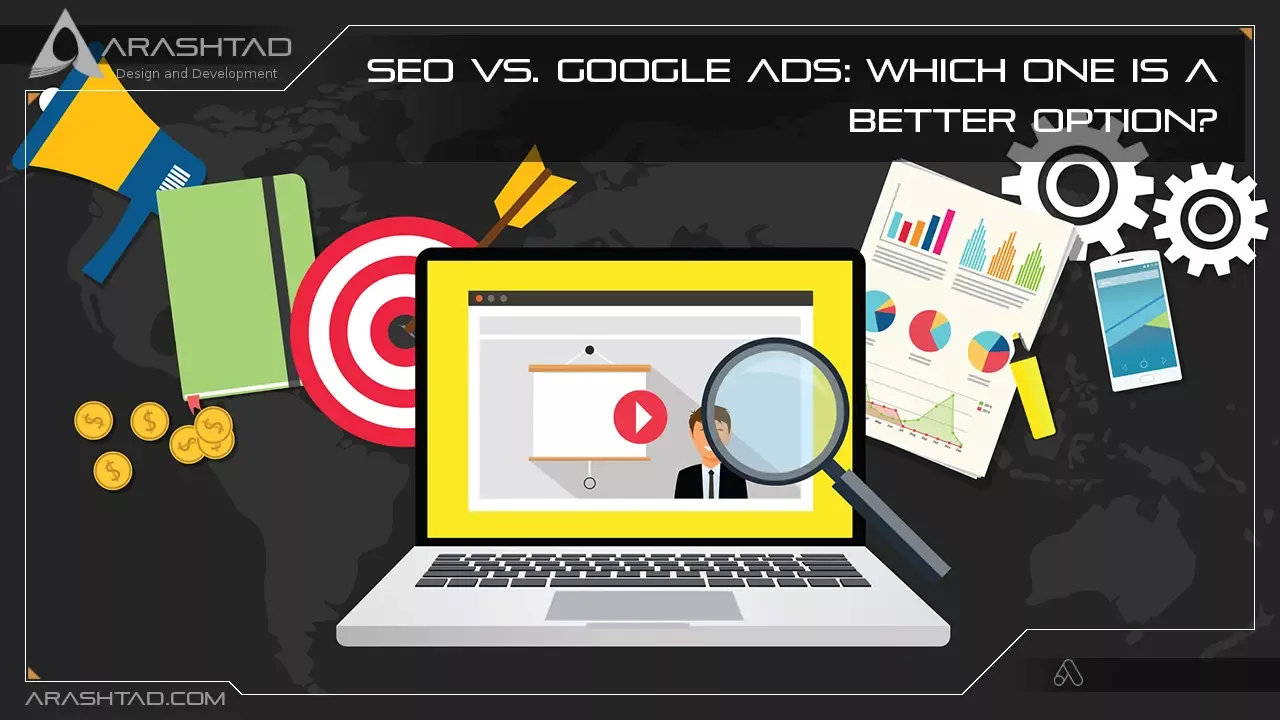SEO Vs. Google Ads: Which one Is a Better Option?
Any digital marketer knows that even the best products and services worldwide don’t sell themselves. SEO and Google Adwords are tried and true solutions to helping them get found by exactly the type of people who would like to buy them. What’s the real difference between them? Does a good digital marketing campaign require both, or is one better than the other? This article aims to help you understand SEO Vs. Google Ads and how you can best use them to achieve your digital marketing goals.
What Is Search Engine Optimization (SEO)?
Search engine optimization (SEO) is a set of techniques, strategies, and best practices for improving the rankings of a website in relevant search engine results pages (SERPs). A search engine user rarely glances at most of the search results that might result from a particular query. 54.4 percent of clicks go straight to the top three search results, and only a small percentage go past page two of search engine results. That said, getting to the first page of a Google search result isn’t enough. You’ll want your site to rank as high as possible and break into the top three if you can. You can accomplish this with the help of SEO techniques such as:
Keyword research
Content marketing
Backlink building
As Google’s algorithm evolves and changes over time, some examples of current best SEO practices include:
1- Use relevant keywords and key phrases throughout a website’s content, metadata, URLs, and image tags.
2- Content should be written in simple, accessible language and formatted to make it easy to skim, read, and digest.
3- Generate clear, engaging, helpful content that addresses users’ needs and concerns.
These articles may also be of interest to you:
How to Improve SEO Rankings?
The Best Way to Research Keywords for SEO
On-Page SEO: A Comprehensive Guide to On-Site Techniques
How to Utilize Website Structure for SEO?
The Best Ways to Optimize Content for SEO
A Complete Guide to Google Ads
What Is Google Ads?
Google Ads is easily the most well-known and most popular pay-per-click (PPC) advertising option available to modern digital marketers. The user of Google Ads pays for their advertising either by clicking or by impressions, as with other PPC platforms. The cost per click varies based on keyword bidding. Paid Google ads appear alongside standard search results, currently appearing in banks at both the top and bottom of the page. In the same way that other search results do, the likelihood that an ad will appear to a search engine user depends on various factors, including the bidding price, ad quality, ad timing, and the quality of the page that the ad links to. Despite not replacing the need for search engine optimization, Google Ads offer several advantages, including:
1- Budget-based customization of individual ad campaigns.
2- Distribution of ads across additional Google-owned platforms, such as YouTube and Blogger.
3- Advertisers can improve future campaigns by analyzing detailed analytics.
SEO Vs. Google Ads
Comparing SEO vs. Google Ads is challenging, as although they serve similar purposes, they are very different. It’s a lot like trying to compare apples to oranges! A long-term SEO strategy is essential to building a loyal audience and reliable network of customers. Google Ads can play a valuable part in generating quick, timely traffic as part of a larger SEO strategy. Here’s a further breakdown of some of the significant differences. The difference between Google Ads and SEO is that Google Ads are paid to advertise everywhere, while SEO is ongoing work, maintenance, and improvement. SEO strategies take weeks or months to produce results, while Google Ads can instantly generate traffic.
As a marketing tool, Google Adwords can be turned on and off at will, while SEO provides long-term organic results. There are no hard limits on how many keywords and long-tail key phrases you can target with Google Ads, but SEO strategies work better with a smaller collection at a time. In Google Ads, you can advertise specific products, promote time-sensitive events, and get a fast influx of traffic when needed. Alternatively, SEO aims to build long-term authority and loyal audiences that will stick with your brand.
How Do Google Ads Help with SEO?

Using Google Ads to enhance your SEO campaign may not directly generate organic traffic like a well-rounded SEO strategy will. Still, you can use them to augment your SEO efforts.
1. Launch a Quick-start SEO Campaign Using Google Ads
Building a business or website into a big success can be difficult to rely exclusively on search engine optimization. Even the best campaigns take a while to gain traction. And building a successful content catalog, a social media following, and a roster of repeat customers can take time. While you wait for your SEO efforts to pay off, Google Adwords can be a great way to drive initial traffic and boost brand awareness. Once you see tangible results from your SEO efforts, you can reduce your spending.
2. Increase Conversions Through Remarketing
If you have checked your products and website before, you already know what your products and website are all about. They’ve already shown interest and taken a moment to evaluate what your solutions might offer. Often, all such consumers need is a firm push in the right direction to convert. By remarketing your products to people who have already shown interest in your brand or your website by viewing them on your site or engaging with your brand elsewhere, Google Ads can help provide that push. Remarketing also referred to as retargeting, is a powerful and effective way to reclaim lost sales.
3. Gain Valuable Insights and Data
Among Google’s many tools, Google Ads is a valuable resource that marketers can use to improve all kinds of things, from future product offerings to ongoing SEO efforts. You can use it to determine which search terms trigger your ads based on the keyword phrase you’re targeting and identify gaps between them. Analyze your Google Ads data to identify and follow search trends. After that, use what you’ve learned to better understand your audience and spend more time creating content that resonates with your existing and potential customers. Ultimately, great SEO is more than just targeting key terms with high overall search volumes. You’ll also need to nail user intent if you’re serious about raising conversion rates and boosting your bottom line.
4. Improve Your Content Marketing Efforts
Content is always king when it comes to building brand awareness and establishing a connection with a loyal audience. Google AdWords is a powerful tool for determining which keywords actually work for your brand — not just in theory. Build conversion-focused landing pages to target the examples with high commercial intent and convince purchase-ready customers to buy now. Create a list of your star options with low commercial intent and use them to guide your content marketing efforts via entertaining, educational, shareable posts.
5. Build Your Local Clientele
People don’t just use search engines to research remote purchasing decisions. More than 60 percent of American consumers use their smartphones, tablets, and other mobile devices to find local solutions on the fly. Additionally, 18 percent of those localized searches result in the sale of the product the same day. A local consumer can be reached with Google Ads and exposed to your brand using Google Ads. This can still be an effective SEO strategy even if you don’t have a brick-and-mortar store. Make your regional and national SEO campaigns more effective with your geo-specific Google Ads data.
SEO Vs. Google Ads: What’s the Best Option Right Now?
What’s the best option between SEO and Google Ads this year and into the future? Although classic SEO and paid options like Google Adwords may be different, they complement one another perfectly. When they are combined in the right ratio, they form a comprehensive, well-rounded digital marketing strategy any business can rely on. Google Ads are fantastic ways to drive fast, timely traffic — especially when used wisely and responsibly. The best way to build long-term success, authority, and brand viability is with SEO.
Wrap Up
As you now understand SEO and Google Adwords better, it’s time to find out how to maximize your Google Adwords campaigns without breaking the bank. Yes, this is paid to advertise, and your budget will ultimately affect your ranking. But that’s only half the story. The rest is about creating relevant, well-designed, and well-suited ads to the content they link to.

